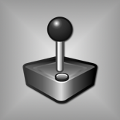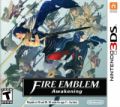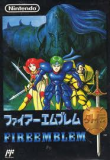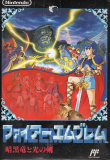Games
Displaying 10901-10910 of 15808 results.
Nintendo DS
Release Date: February 16, 2009 |
Genre: Role-Playing
A reinvention of the original NES titles with revamped graphics and intuitive touch control, Fire Emblem: Shadow Dragon will finally introduce longtime fans to the stories that gave birth to the series nearly 20 years ago in Japan, while introducing the Fire Emblem franchise to a broader audience of strategy and chess fans. Fire Emblem: Shadow Dragon also reveals the back story of Marth, the original lead character in the Fire Emblem series introduced and made popular in North America by the Super Smash Bros. series of fighting games.
Super Nintendo (SNES)
Release Date: May 14, 1996 |
Genre: Role-Playing, Strategy
Fire Emblem: Seisen no Keifu (Fire Emblem: Genealogy of Holy-War) is a Japanese Super Famicom tactical role-playing game developed by Intelligent Systems and published by Nintendo. It was released on May 14, 1996 in Japan. It is the fourth title in the Fire Emblem series, the second Fire Emblem title for the Super Famicom and was the last game produced by Gunpei Yokoi. The game has received recognition outside Japan through imports and console emulation, including an unofficial emulation fan translation into English.
Nintendo Wii
Release Date: November 5, 2007 |
Genre: Role-Playing
The sequel to 2005's Path of Radiance and the tenth game in the Fire Emblem series, Radiant Dawn takes place three years after the defeat of the Daein kingdom by Crimea.
Unlike other Wii games, the main method of control is either through the classic controller or GameCube controller, since the action is wholly turn-based tactical combat, largely the same as the previous nine games. The game consists of 44 chapters and uses the same engine as Path of Radiance. There are three new weapon and magic types: Knife, Dark Magic and Strike.
The player must lead a band of heroes against the Begnion Empire's oppression of the defeated Daein, along with help from many of the heroes from Path of Radiance. The members of the Dawn group are the main heroes of the game, with a major role for Sothe, who was a child thief from the previous Fire Emblem game.
Nintendo GameCube
Release Date: October 17, 2005 |
Genre: Role-Playing
Fire Emblem: Path of Radiance brings back to consoles the strategic combat series Fire Emblem from the Game Boy Advance. In this installment, you can control units such as knights, mages, and winged creatures, and use their unique fighting styles to win battles and gain experience. Fire Emblem: Path of Radiance also includes a detailed story that connects the battles and characters together.
Super Nintendo (SNES)
Release Date: January 21, 1994 |
Genre: Role-Playing, Strategy
Fire Emblem: Monshō no Nazo (Fire Emblem: Mystery of the Emblem) is a Japanese tactical role-playing game developed by Intelligent Systems and published by Nintendo. It was released in Japan on January 21, 1994. It was the first Fire Emblem title for the Nintendo Super Famicom and the first twenty-four-megabit cartridge for the system. The game is divided into two distinct parts, or books. Book One is a remake of the original Fire Emblem: Ankoku Ryū to Hikari no Ken, and Book Two is a continuation of events, following the same characters.
Nintendo Game Boy Advance
Release Date: March 29, 2002 |
Genre: Role-Playing
Fire Emblem: Fūin no Tsurugi is a turn-based tactical role-playing game in which players move a small group of units around a square-based grid, battling their enemies in order to complete a certain predefined objective. It is reminiscent of other tactical RPGs with features such as character classes and the ability to level up.
Nintendo 3DS
Release Date: February 4, 2013 |
Genre: Role-Playing
Fire Emblem Awakening offers a unique blend of in-battle strategy, vast character customization, and lush 3D cinematic graphics that appeal to a wide range of gamers. In this game, you'll join Chrom, brother to Ylisse's empress and commander of its forces, in a fantasy world teetering on the brink of war. It's your duty to guide a team of Ylisse's finest soldiers--knights, mages, archers, and more--against the marauding Plegian bandits. To succeed, you will need to carefully choose the units you take into battle. As you lead your team through battles across maps that span entire kingdoms, your army will grow. Some characters are willing to join you quickly, while others may need more persuasion. Each character earns experience in battle, leveling up and gaining strength and abilities as they do so. It's up to you to guide their moves, choose their weapons, and direct their attacks.
Nintendo Entertainment System (NES)
Release Date: March 14, 1992 |
Genre: Strategy
Nintendo DS
Release Date: July 15, 2010 |
Genre: Role-Playing
Fire Emblem: Shin Monshou no Nazo, Hikari to Kage no Eiyuu (ファイアーエムブレム新・紋章の謎~光と影の英雄, Fire Emblem: Shin Monshō no Nazo, Hikari to Kage no Eiyū), translated as Fire Emblem: New Mystery of the Emblem, Heroes of Light and Shadow is the second Fire Emblem remake for the Nintendo DS system, following after Shadow Dragon. It is a remake of Monshou no Nazo, the third Fire Emblem game to have been made.
Nintendo Entertainment System (NES)
Release Date: April 20, 1990 |
Genre: Strategy
The Fire Emblem series of turn-based tactics games centers around moving units through a map grid in order to defeat the opposition. Players use strategic movements and positioning to complete mission objectives such as seizing a base, surviving for a number of turns, or defeating a boss. Many conventions of traditional console role-playing games are also present; for example, there is extensive use of scripted cutscenes to advance the story, units gain experience points and grow stronger over the course of the campaign, and the player can visit shops to outfit characters with weapons and equipment. Depending on the game, these events may take place during or in-between battles.
The combat system bases itself on a rock-paper-scissors method of fighting, as each weapon type has both an advantage and a disadvantage against other types. Starting in the fourth game, Fire Emblem: Seisen no Keifu, the weapon triangle has been lance beats sword, sword beats axe, and axe beats lance. Bows are unaffected by the triangle, can attack from a distance, and do higher amounts of damage against flying units like pegasi, but this is offset by the bow-wielder's inability to counter-attack melee strikes. A similar magic triangle exists in some games. In the Game Boy Advance Fire Emblem games, light beats dark, dark beats anima, and anima beats light. In other games, fire beats wind, wind beats thunder, and thunder beats fire. Magic and certain axes and spears can be used either from a distance or in melee range.
Unlike in most other games, most weapons in the Fire Emblem series have a finite number of uses and will eventually break. Therefore, the player must often buy replacement weapons or spend gold to have broken weapons repaired. Typically, weaker weapons allow more uses than more powerful ones, and are often more accurate.





